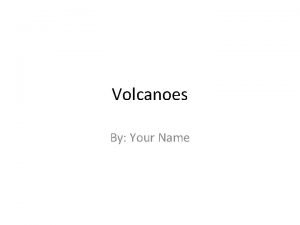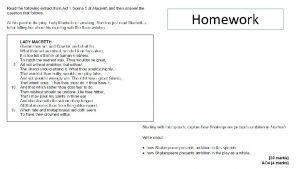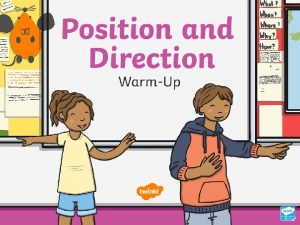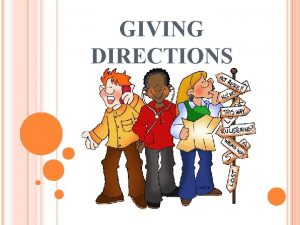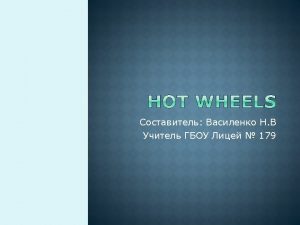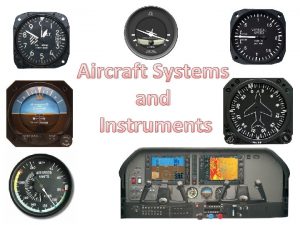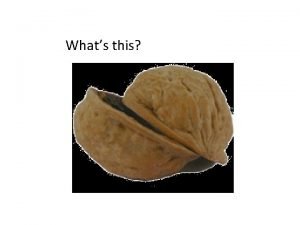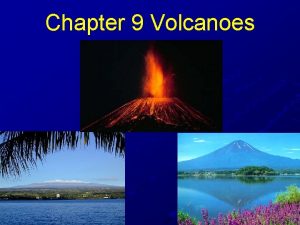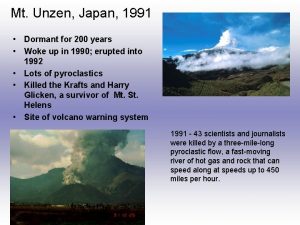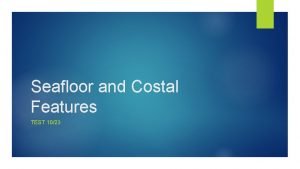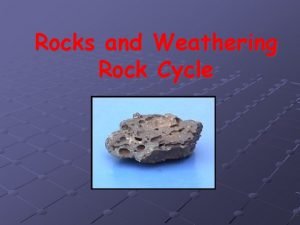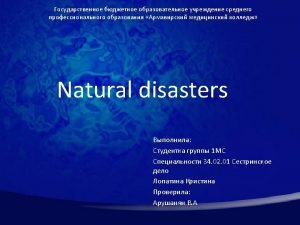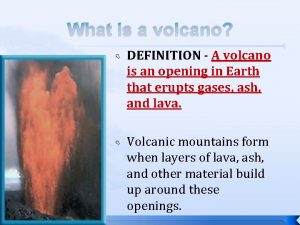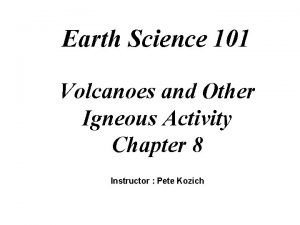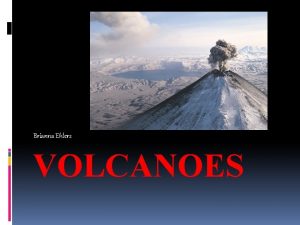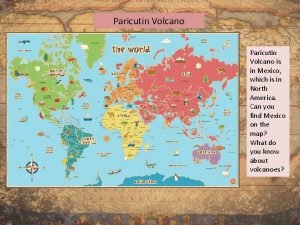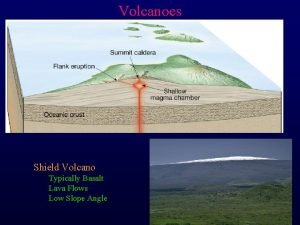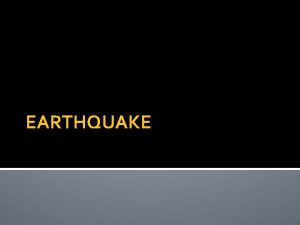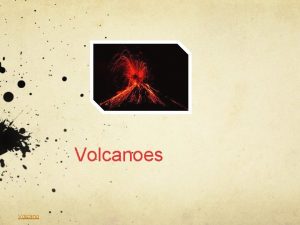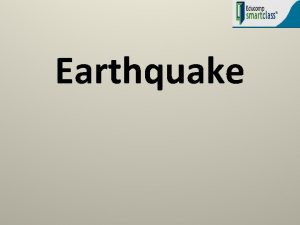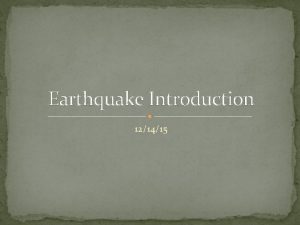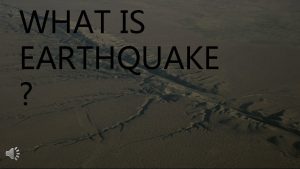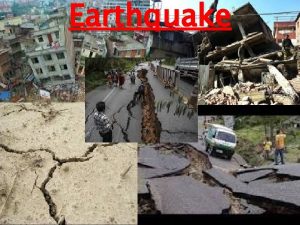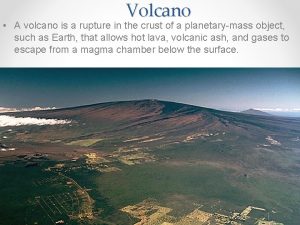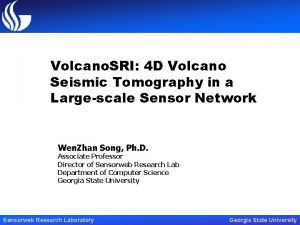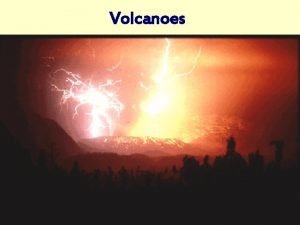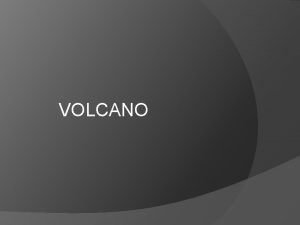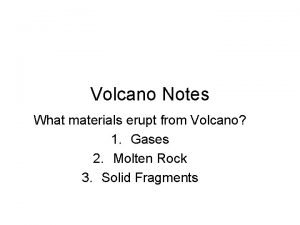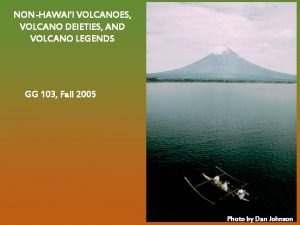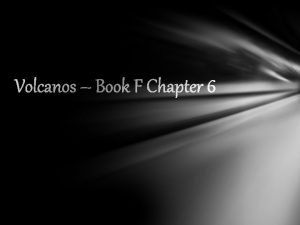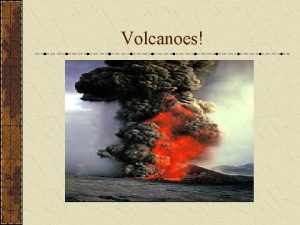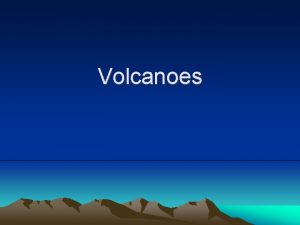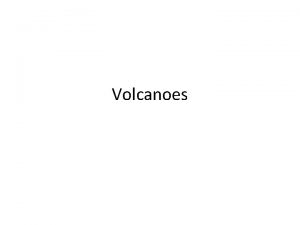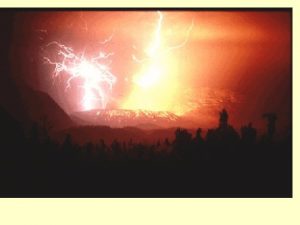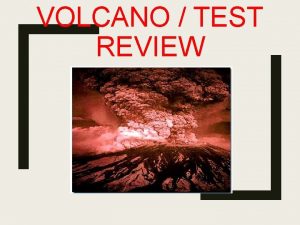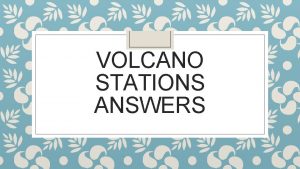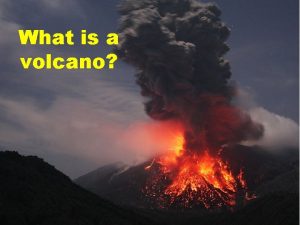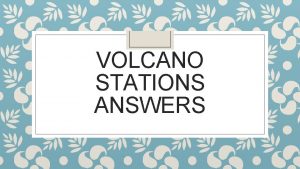Do First Actions Turn in Volcano vs Earthquake























- Slides: 23

Do First Actions: Turn in Volcano vs Earthquake Webquest Questions: 1. What type of plate interaction(s) forms volcanos? 2. What type of plate interaction(s) does not form volcanos? Boys rules still apply, hop up and get 30 minutes with me

Agenda • Test is Wednesday: Plate Tectonics, Earthquakes, and Volcanos • Volcano Notes • Volcano Video

Pixar Video https: //www. youtube. com/watch? v=uh 4 d. TLJ 9 q 9 o

What is a volcano? • A volcano is a rupture on the crust that allows hot lava, volcanic ash, and gases to escape from a magma chamber below the surface

Where do Volcanos occur? • Volcanos mostly occur at convergent and divergent plate boundaries • Plate motion causes mantle rocks to melt to form magma

What causes volcanoes?

Where do Volcanos occur? • Convergent boundaries produce volcanic arcs • At Ocean – ocean convergent boundaries rising magma can form volcanic arcs in an ocean (Aleutian Islands). • At Ocean – continental boundaries rising magma can form continental volcanic arcs (Andes Mountains). • 75% of volcanos occur in the “Ring of Fire” • Divergent boundaries produce the greatest volume of volcanic rock along the oceanic ridge system

Where do Volcanos occur? • The remaining volcanos occur within a plate and not at a boundary which is called intraplate volcanism • The regions are known as “hot spots” • Volcanos occur here because a mass of hotter than normal mantle material called a mantle plume rises toward the surface. • The Pacific plate moves over a hot spot, producing the Hawaiian Islands.

Mantle Convection Models

Hot Spots

Types of Eruptions • Violent (Explosive) • Destroy the volcano • Viscous (thick) lava traps the gases until large pressures build up & the system explodes • Pyroclastic flow (ash, rock fragments) flow out of vent • Non-violent (Calm or Quiet) • Build up the volcano • Fluid lava flows easily allows gases to bubble away

Types of Lava • Lava is what magma is referred to once it reaches the surface • Viscous Lava (Thick) • Cool temperature • Composition: silica-rich (granitic) • Fluid Lava (Thin) • Higher temperatures • Composition: Low silica (basaltic)

Other Ejected Materials • Dissolved gases • Mainly water vapor and carbon dioxide • If gases escape easily then eruption is less explosive • Pyroclastic Materials • particles produced in volcanic eruptions • Range in size from very fine duct and volcanic ash (less than 2 millimeters) to pieces that weigh several tons

Pompeii After the 79 C. E. eruption

Parts of a Volcano • A volcano is a mountain formed of lava and/or pyroclastic material. • A crater is the depression at the summit of a volcano or that which is produced by a meteorite impact. • A conduit, or pipe, carries gas-rich magma to the surface.

Types of Volcanos Shield volcano Composite volcano Cinder cone volcano

Types of Volcanos • The three main volcanic types are shield volcanoes, cinder cones, and composite cones.

Types of Volcanos • Shield Volcanoes • Shield volcanoes are broad, gently sloping volcanoes built from fluid lavas.

Types of Volcanos • Cinder Cones • Cinder cones are small volcanoes built primarily of pyroclastic material ejected from a single vent • Steep slope angle • Rather small in size • Frequently occur in groups

Types of Volcanos • Composite Cones • Composite cones are volcanoes composed of both lava flows and pyroclastic material. • Large size • Alternating layers of lavas and pyroclastics • Most violent type of activity

Types of Volcanos • Volcanos can also be defined by when they are expected to erupt • Active: has erupted in the last 10, 000 years • Dormant: hasn’t erupted in the last 10, 000 years but it expected to erupt again • Extinct: hasn’t erupted in the last 10, 000 years and is not expected to erupt again

Mount St. Helens Before and After the May 18, 1980, Eruption https: //www. youtube. com/watch? v=UK--hvg. P 2 u. Y

DYL • 1. What are three types of volcanos? • 2. What is a hot spot?
 A dome mountain forms when _____.
A dome mountain forms when _____. Macbeth seeing banquo's ghost quote
Macbeth seeing banquo's ghost quote Quarter turn half turn
Quarter turn half turn Answer. go straight turn left turn right
Answer. go straight turn left turn right Go straight ahead then turn left
Go straight ahead then turn left Turn left go straight
Turn left go straight What is 1/4 turn clockwise
What is 1/4 turn clockwise Themes about guilt
Themes about guilt You can't turn right here. you turn left
You can't turn right here. you turn left Valiant cousin macbeth
Valiant cousin macbeth A tomato flames flaps
A tomato flames flaps Hellhound macbeth
Hellhound macbeth Funnel shaped pit at the top of a volcano
Funnel shaped pit at the top of a volcano What type of volcano is mt unzen
What type of volcano is mt unzen Underwater volcano pictures
Underwater volcano pictures Volcano
Volcano Phenomenon disaster
Phenomenon disaster Definition of composite volcano
Definition of composite volcano Big island size broad slightly domed volcano
Big island size broad slightly domed volcano Raging planet volcano
Raging planet volcano Cinder cone def
Cinder cone def Paricutin volcano facts
Paricutin volcano facts Perbedaan hot lava dan hot lava volcano
Perbedaan hot lava dan hot lava volcano Basalt volcano
Basalt volcano
